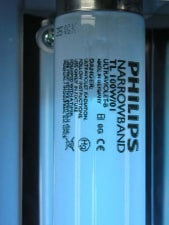Vitamin D Light Therapy - Information
Using a UVB Lamp for vitamin D
Vitamin D is essential to human health for its role as a catalyst for calcium absorption, yet many people are deficient, especially those that live at higher latitudes, far away from the earth’s equator. In these areas, the tilt of the earth in the winter months forces the sun’s rays to travel a longer path through the earth’s atmosphere, filtering the UVB light necessary for reactions within the skin to create Vitamin D. Vitamin D protects against the development of many chronic diseases, including: cancer (breast, colorectal, prostate), cardiovascular disease, multiple sclerosis, osteomalacia, osteoporosis, type 1 diabetes mellitus, rheumatoid arthritis, hypertension, and depression.
Background - Quick Facts
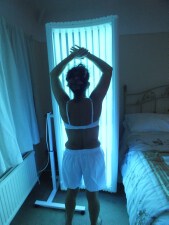 Over millions of years of exposure to sun, the human body has evolved the need for UVB and Vitamin D for general health. Nearly every cell in the human body has a vitamin D receptor.
Modern lifestyles, geographic location and use of sunscreens prevent most of us from getting adequate UVB exposure. Only UVB light makes Vitamin D in skin. The other wavelengths such as UVA are not necessary and possibly hazardous. The sun makes all types of UV, but in high latitudes in the winter, very little UVB reaches the earth. The UVB content of natural sunlight is highly variable, making proper dosing very difficult. UVB varies with latitude, time-of-day, time-of-year, altitude, cloud cover, and pollution. Skin colour is a filter for UV light and greatly effects UVB treatment times. Evolution has selected dark skin for those that live in tropical regions, and light skin for the northerners.
UVB treatment times are very important because too much UVB will cause burning and as with natural sunlight, use of a UVB phototherapy device can cause skin cancer and premature aging of the skin. Avoid cosmetic tanning equipment because this makes mostly UVA and only a small amount of UVB. UVB light does not typically cause excessive skin tanning, and it is the UVB element that helps to produce and increase the level of vitamin D and not UVA.
Over millions of years of exposure to sun, the human body has evolved the need for UVB and Vitamin D for general health. Nearly every cell in the human body has a vitamin D receptor.
Modern lifestyles, geographic location and use of sunscreens prevent most of us from getting adequate UVB exposure. Only UVB light makes Vitamin D in skin. The other wavelengths such as UVA are not necessary and possibly hazardous. The sun makes all types of UV, but in high latitudes in the winter, very little UVB reaches the earth. The UVB content of natural sunlight is highly variable, making proper dosing very difficult. UVB varies with latitude, time-of-day, time-of-year, altitude, cloud cover, and pollution. Skin colour is a filter for UV light and greatly effects UVB treatment times. Evolution has selected dark skin for those that live in tropical regions, and light skin for the northerners.
UVB treatment times are very important because too much UVB will cause burning and as with natural sunlight, use of a UVB phototherapy device can cause skin cancer and premature aging of the skin. Avoid cosmetic tanning equipment because this makes mostly UVA and only a small amount of UVB. UVB light does not typically cause excessive skin tanning, and it is the UVB element that helps to produce and increase the level of vitamin D and not UVA. Treating Vitamin D with Philips TL01 & PL01 Lamps - The Facts
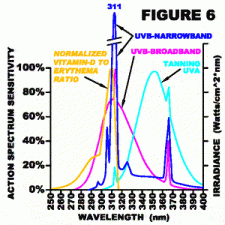
Several medical studies have shown the effectiveness of UVB-NB in producing Vitamin D. As with UVB Broadband, UVB Narrowband lamps typically provide little tanning effect because dosing is limited by erythema, long before the UVA content can cause tanning. In other words, the UVB-NB spectral profile is too heavily weighted in UVB to allow significant tanning effects (78% of total UV output is UVB – beneficial for the treatment of vitamin D).
Typical treatment times range from a few seconds to a maximum of a couple of minutes, (see exposure guidelines below). After a few weeks of diligent UVB treatments, a substantial increase in the patient’s vitamin D blood level would be expected. With restoration of this vitally important nutient, it is sensible to expect that there would be health benefits for suffering patients, possibly profound.
The important technical/medical point in this is that only UVB is needed to make vitamin D in human skin, and Philips Narrowband produces mainly UVB. This means that only the most beneficial ultraviolet-B wavelengths of light are delivered, with a minimal amount of unnecessary and possibly hazardous UVA.
MBS Units for increasing Vitamin D levels
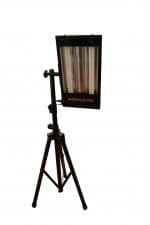
- UVB light occurs NATURALLY in sunlight. MBS devices produce a more concentrated UVB light using artificial light sources by utilising a tube called Philips TL01 or PL01 UVB narrowband. This tube has 78.8% UVB to total UV output (a sunbed tube is 3.4% to 4.5%).
- Artificial light sources have the advantage of providing only the most therapeutic wavelengths of UV light, while minimizing the potentially harmful non-therapeutic wavelengths.
- Artificial light sources allow much more accurate UVB dosing than using natural sunlight, which controls the possibility of sunburn.
- A single full body dose of UVB can make the equivalent of 10,000 to 25,000 IU of oral vitamin D, without the patient being burned.
- Home UVB light therapy units are very low maintenance. The Philips UVB bulbs last 10 years or longer (over 1000hrs usage)!
- Home use enables you to go directly from the shower or bath to the light unit and this increases the treatment effectiveness.
Exposure and Treatment Guidelines
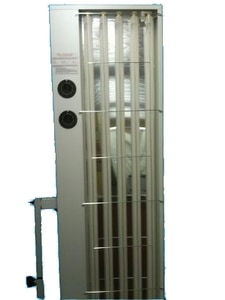 The use of the MBS equipment is most beneficial in the winter months when natural sunlight is at a premium. Keep your session times to a minimum for vitamin D deficiency – with the larger TL01 canopy units a 60 second exposure to the light is usually enough (start off on 20 seconds and build your time up gradually), use the unit every other day, get your vitamin D levels checked regularly as you will experience a dramatic rise in your vitamin D.
With the smaller (mini unit) units using PL01 tubes, then you may use the unit every other day as well for approx. 1 minute session. The smaller PL01 units do not have the same concentration (irradiance) of UVB that the larger units have so may take slightly longer period of time to raise your vitamin D levels to your required level.
Whichever unit you use, if you experience any burning or feel uncomfortable reduce your session time. People with fair hair or very sun sensitive skin are most at risk. Always protect your eyes by using the goggles provided.
Don’t use the unit continuously, give your body a complete rest every other month (maximum 8 weeks continuously usage with the smaller PL01 unit – at the very most) – don’t forget overuse may result in skin wrinkling or skin cancers so be careful. Consider as well giving your body a complete break from the unit in the summer months when natural sunlight is available.
Follow the other safety advice in the general safety sheet aimed at psoriasis and vitiligo sufferers. We do not recommend the use of this unit for anyone under 18 years old without consulting with a doctor.
Always wear the goggles! Ultraviolet light can permanently damage your eyes. Don’t be fooled by the innocent look of the blue light. Ultraviolet light is invisible!
Don’t get burned! Be conservative and don’t experiment carelessly. Do not repeat treatments within 24 hours. Repeated exposure may cause premature aging of the skin and skin cancer, try to minimize the total cumulative use of the system over your lifetime. Find a balance between your treatment frequency, dose, vitamin-D blood level and other treatment / lifestyle options. Don’t overdo it!
The use of the MBS equipment is most beneficial in the winter months when natural sunlight is at a premium. Keep your session times to a minimum for vitamin D deficiency – with the larger TL01 canopy units a 60 second exposure to the light is usually enough (start off on 20 seconds and build your time up gradually), use the unit every other day, get your vitamin D levels checked regularly as you will experience a dramatic rise in your vitamin D.
With the smaller (mini unit) units using PL01 tubes, then you may use the unit every other day as well for approx. 1 minute session. The smaller PL01 units do not have the same concentration (irradiance) of UVB that the larger units have so may take slightly longer period of time to raise your vitamin D levels to your required level.
Whichever unit you use, if you experience any burning or feel uncomfortable reduce your session time. People with fair hair or very sun sensitive skin are most at risk. Always protect your eyes by using the goggles provided.
Don’t use the unit continuously, give your body a complete rest every other month (maximum 8 weeks continuously usage with the smaller PL01 unit – at the very most) – don’t forget overuse may result in skin wrinkling or skin cancers so be careful. Consider as well giving your body a complete break from the unit in the summer months when natural sunlight is available.
Follow the other safety advice in the general safety sheet aimed at psoriasis and vitiligo sufferers. We do not recommend the use of this unit for anyone under 18 years old without consulting with a doctor.
Always wear the goggles! Ultraviolet light can permanently damage your eyes. Don’t be fooled by the innocent look of the blue light. Ultraviolet light is invisible!
Don’t get burned! Be conservative and don’t experiment carelessly. Do not repeat treatments within 24 hours. Repeated exposure may cause premature aging of the skin and skin cancer, try to minimize the total cumulative use of the system over your lifetime. Find a balance between your treatment frequency, dose, vitamin-D blood level and other treatment / lifestyle options. Don’t overdo it! Factors that influence the strategy for safe and effective UVB phototherapy for Vitamin-D are:
UVB risks such as skin cancer and premature aging of the skin are directly related to local cumulative UVB exposure at a skin site over a person’s lifetime. UVB can be obtained from both artificial light sources and natural sunlight. Artificial light sources can include this UVB phototherapy device and, to a lesser extent, cosmetic tanning machines (mainly UVA and very small amount of UVB – and even more dangerous for cancers and skin wrinkling). The UVB content of natural sunlight depends on many factors including the time of year (with June 21st being peak UVB for the northern hemisphere), time of day (with early afternoon being the daily maximum), geographic latitude (greater UVB towards the earth’s equator), altitude (greater UVB at higher elevations), and other environmental factors such as cloud cover. Natural sunlight typically results in greater cumulative UVB exposure on the face/head, lower arms, chest and shoulders/upper back.
Skin burning is caused by excessive UVB, and occurs when the minimum erythema dose (1 MED) has been exceeded. Skin cancer has been linked to skin burning (erythema), especially when the burns occur at a young age.
The only effective method to determine your Vitamin-D level is by Vitamin-D blood testing.
Considering the above, a reasonable strategy for safe and effective Vitamin-D phototherapy is to:
- Follow all of the instructions provided.
- “Generalize” (or “evenly distribute”) the UVB light, so all areas of the skin can contribute to making Vitamin-D in the skin, which lowers the UVB dose to any particular area while maximizing Vitamin-D production. Depending on the device used, this usually requires more than one patient body position.
- Exclude areas of skin that have received large cumulative doses of UVB in a person’s lifetime, or areas that were previously sunburned, such as possibly the face/head, lower arms, chest and shoulders/upper back. These areas should be protected by sunscreen or physically covered using clothing. Consider cutting away portions of clothing to expose certain areas, to protect the face/head when using a full body device.
- If within 24 hours a significant amount of UVB has been received from other sources, such as natural sunlight or a tanning machine (mainly UVA), skip phototherapy treatments or exclude affected areas from treatment.
- Record the treatment time given to each skin area.
- Take regular Vitamin-D blood tests, to find the lowest UVB dose and frequency necessary to maintain the desired Vitamin-D level.
